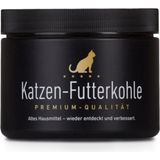Cushing - Controversial Disease No. 1?
Are there long curls in your horses hair? Has he/she got that bedhead look? While this might sound incredibly cute, they could be the external symptoms of Equine Cushing's Syndrome - a disease that is commonly defined as the result of increased energy intake and tumor-like changes in the horse's body. In this new Carbon article, we take a critical look at the topic of Cushing's syndrome and explain how it expresses itself and what treatment and feeding recommendations there are post-Cushing diagnosis.
Equine Cushing Syndrome (ECS or Cushing for short) is a hormone-controlled disease that is increasingly being diagnosed and frequently unsettles horse owners. Equine Cushing's Syndrome is triggered by a disease of the pituitary gland.
The pituitary gland produces various hormones, which enter the horse's body via the bloodstream and ensure the maintenance and control of various body functions. In Cushing-suffering horses, it is assumed that benign tumors on the pituitary gland disrupt the production and release of hormones. In affected horses the production of the messenger hormone dopamine is greatly reduced. Dopamine has an important role in the control centre of the pituitary gland, which, among other things, is responsible for the production of the important hormone ACTH (adrenocorticotropic hormone). This in turn orders the adrenal cortex to release cortisol. The result? The body is flooded with Cortisol and ACTH.
Cortisol and ACTH are stress hormones and this is exactly where the problem begins. The diagnosis of Cushing is usually made on the basis of the increased ACTH values in the normal blood count. Whether a tumor of the pituitary gland is actually present or whether stress and its consequences are decisive is not determined. In the course of the season, the hormone concentration in the blood is also subject to completely natural fluctuations; the increase in ACTH is most pronounced in early autumn (September/October) and it is precisely at this time of year that the most frequent Cushing diagnoses are made, statistically speaking. There are also very different approaches to treating a Cushing-suffering horse.
Whether it is stress that's the trigger or a malfunctioning pituitary gland, the external picture of Cushing's syndrome includes a change in coat with thick, long and sometimes curly hair developing on the chin and on the back of the legs. This coat growth doesn't correspond to seasonal/temperature related coat changes as it normally should. Additionally there can be muscle breakdown and changes in fat deposits ("little back, lots of stomach"), blatant and obvious drops in performance and increased lethargy, extremely frequent urination and increased thirst, sweating without stress, recurring infectious diseases due to a weakened immune system, e.g. inflammation of the cornea, skin fungus or hoof abscesses.
The treatment of the misdirected hormone release is traditionally carried out with a drug that replaces the missing dopamine and thus in turn prevents the body from being flooded with cortisol and ACTH. Even if it sounds easy to put an end to the problem with a pill, it is worthwhile to critically examine other treatment alternatives. In various studies on the feed history of affected horses, extreme nutrient deficiencies were often found. The combination of years of malnutrition with excessive energy intake and too little physical can be a real trigger. Parasite infestation, a lack of trace elements or undetected dental problems (which trigger permanent pain centers) increase the stress level. Whether equine Cushing's Syndrome is always a tumor-related hormonal disorder - or whether it has other, more diverse causes remains to be seen and investigated. In any case, all thestress and pain triggers of the affected horses should be identified and dealt with.
We at CharLine recommend an absolutely needs-based diet, which should be determined based on the type of husbandry, the personal constitution of the horse as well as the level of training and regular work. Essential elements are a moderate starch and sugar intake, no excess weight, an adequate supply of trace elements and an energy content appropriate to the required performance. The additional use of CharLine feed charcoal can be particularly useful when a change in feed is required and to improve the absorption of minerals into the body by removing harmful toxins. In Cushing's patients we have had excellent experiences with the permanent administration of charcoal, especially with regard to the alleviation of symptoms caused by metabolic disorders such as diarrhea. In the conventional drug treatment of Cushing's syndrome using tablets, the CharLine feed charcoal can be given with one of the daily meals for which the tablets are not administered. This ensures that the feed charcoal can have the same effect as the medication.
The CharLine team has our own resident expert for feed advice - Anna Maria Rumer brings 15 years of experience in this area and is available for all questions about the perfect feeding of your horses and the supportive use of CharLine feed coal!
© Anne Lorf CharLine
Related products
-
 4.8 (36)
4.8 (36)CharLine Charcoal Feed Pellets for Horses, 5 kg
- Support for the intestines
- Neutral in taste and smell
- Free from additives
€ 69,99 (€ 14,00 / kg)Delivery by April 23
-
 4.9 (17)
4.9 (17)CharLine Charcoal Feed Powder for Dogs, 450 g
- Eliminates harmful substances
- Supports the gastrointestinal tract
- Odourless & tasteless
€ 46,99 (€ 104,42 / kg)Delivery by April 23
-
 5.0 (2)
5.0 (2)CharLine Charcoal Feed for Cats, 175 g
- Binds & eliminates harmful substances and toxins
- Tried and true home remedy for gastrointestinal problems
- Odourless & tasteless, therefore well accepted
€ 31,99 (€ 182,80 / kg)Delivery by April 23
-

CharLine Charcoal Feed Powder for Cattle, 10 kg
- Eliminates harmful & toxic substances
- Supports metabolism
- In stressful situations & when changing food
€ 45,99 (€ 4,60 / kg)Delivery by April 23
